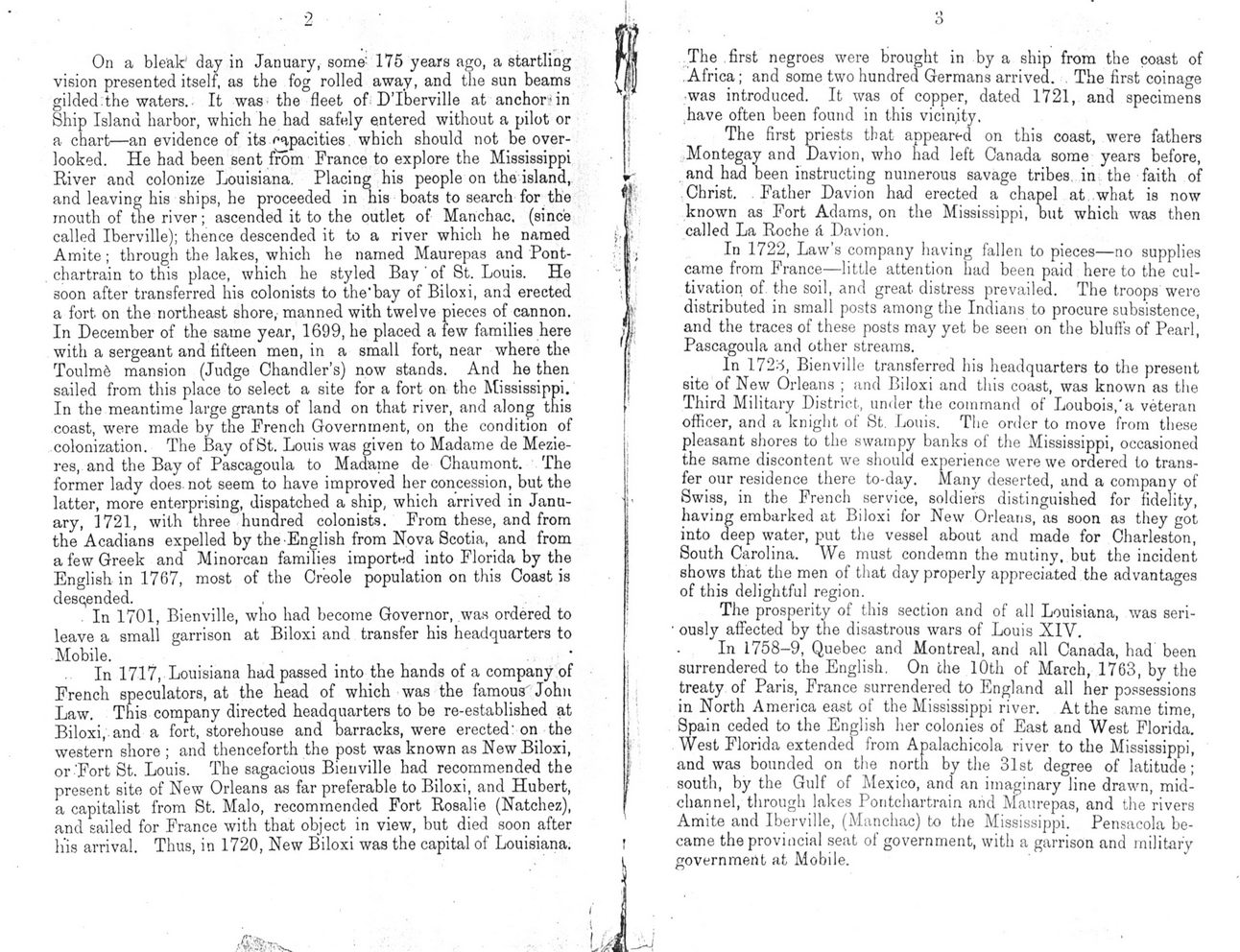This text was obtained via automated optical character recognition.
It has not been edited and may therefore contain several errors.
On a bleak day in January, some: 175 years ago, a startling vision presented itself, as the fog rolled away, and the sun beams gilded.the waters. It was the fleet of D?Iberville at anchor'in Ship Island harbor, which he had safely entered without a pilot or a chart?an evidence of its capacities which should not be overlooked. He had been sent from France to explore the Mississippi River and colonize Louisiana. Placing his people on the island, and leaving his ships, he proceeded in his boats to search for the mouth of the river; ascended it to the outlet of Manchac, (since called Iberville); thence descended it to a river which he named Amite ; through the lakes, which he named Maurepas and Pont-chartrain to this place, which he styled Bay ' of St. Louis. He soon after transferred his colonists to the'bay of Biloxi, and erected a fort on the northeast shore, manned with twelve pieces of cannon. In December of the same year, 1699, he placed a few families here with a sergeant and fifteen men, in a small fort, near where the Toulmd mansion (Judge Chandler?s) now stands. And he then sailed from this place to select a site for a fort on the Mississippi. In the meantime large grants of land on that river, and along tnis coast, were made by the French Government, on the condition of colonization. The Bay of St. Louis was given to Madame de Mezie-res, and the Bay of Pascagoula to Madame de Chaumont. The former lady does not seem to have improved her concession, but the latter, more enterprising, dispatched a ship, which arrived in January, 1721, with three hundred colonists. From these, and from the Acadians expelled by the English from Nova Scotia, and from a few Greek and Minorcan families imported into Florida by the English in 1767, most of the Creole population on this Coast is descended. In 1701, Bienville, who had become Governor, was ordered to leave a small garrison at Biloxi and transfer his headquarters to Mobile. In 1717, Louisiana had passed into the hands of a company of French speculators, at the head of which was the famous John Jjaw. This company directed headquarters to be re-established at Biloxi, and a fort, storehouse and barracks, were erected: on the western shore ; and thenceforth the post was known as New Biloxi, or Fort St. Louis. The sagacious Bienville had recommended the present site of New Orleans as far preferable to Biloxi, and Hubert, a capitalist from St. Malo, recommended Fort Rosalie (Natchez), and sailed for France with that object in view, but died soon after his arrival. Thus, in 1720, New Biloxi was the capital of Louisiana. o O The first negroes were brought in by a ship from the coast of Africa; and some two hundred Germans arrived. The first coinage ?was introduced. It was of copper, dated 1721, and specimens .have often been found in this vicinity. The first priests that appeared on this coast, were fathers Montegay and Davion, who had left Canada some years before, and had been instructing numerous savage tribes in the faith of Christ. Father Davion had erected a chapel at what is now known as Fort Adams, on the Mississippi, but which was then called La Roche A Davion. In 1722, Law?s company having fallen to pieces?no supplies came from France?little attention had been paid here to the cultivation of the soil, and great distress prevailed. The troops were distributed in small posts among the Indians to procure subsistence, and the traces of these posts may yet be seen on the bluffs of Pearl, Pascagoula and other streams. In 1723, Bienville transferred his headquarters to the present site of New Orleans ; and Biloxi and this coast, was known as the Third Military District, under the command of Loubois.'a veteran officer, and a knight of St. Louis. The order to move from these pleasant shores to the swampy banks of the Mississippi, occasioned the same discontent we should experience were we ordered to transfer our residence there to-day. Many deserted, and a company of Swiss, in the French service, soldiers distinguished for fidelity, having embarked at Biloxi for New Orleans, as soon as they got into deep water, put the vessel about and made for Charleston, South Carolina. We must condemn the mutiny, but the incident shows that the men of that day properly appreciated the advantages of this delightful region. The prosperity of this section and of all Louisiana, was seriously affected by the disastrous wars of Louis XIV. In 1758-9, Quebec and Montreal, and all Canada, had been surrendered to the English. On the 10th of March, 1763, by the treaty of Paris, France surrendered to England all her possessions in North America east of the Mississippi river. At the same time, Spain ceded to the English her colonies of East and West Florida. West Florida extended from Apalachicola river to the Mississippi, and was bounded on the north by the 31st degree of latitude ; south, by the Gulf of Mexico, and an imaginary line drawn, midchannel, through lakes Pontchartrain and Maurepas, and the rivers Amite and Iberville, (Manchac) to the Mississippi. Pensacola became the provincial seat of government, with a garrison and military government at Mobile.

Claiborne, J.F.H Claiborne-J.F.H-123